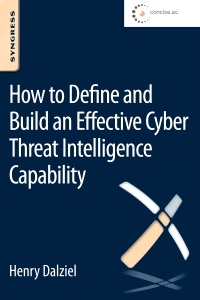Description
How to Define and Build an Effective Cyber Threat Intelligence Capability
Author: Dalziel Henry
Coordinators: Olson Eric, Carnall James
Language: English
Subjects for How to Define and Build an Effective Cyber Threat...:
Keywords
access controls; Action Script Spray; address space layout randomization (ASLR); Adobe Flash; Adobe Reader sandbox; antivirus systems; application whitelisting solutions; BIOS-kit; bootkit; bring your own device (BYOD); cloud computing; copy-on-write (CoW); cyber-attack; data execution prevention (DEP); desktop firewalls; desktop virtualization systems; endpoint protection; endpoint protection industry (EPP); forensic analysis; hardware-virtualization; honeypots; host intrusion prevention systems; hypercall interface; hypervisor; least privilege; malware; micro-VMs; micro-Xen; Microsoft MAPP; Microsoft Office; Microsoft� Internet Explorer; Microsoft� Systems Center; microvirtualization; microvisor; patch management solutions; payload; polymorphic malware; ROC curve; sandboxes; sandboxing; spear phishing; STIX/MAEC; trust domains; virtualization; Xen hypervisor; zero day
Support: Print on demand
Description
/li>Contents
/li>Biography
/li>Comment
/li>
Intelligence-Led Security: How to Understand, Justify and Implement a New Approach to Security is a concise review of the concept of Intelligence-Led Security. Protecting a business, including its information and intellectual property, physical infrastructure, employees, and reputation, has become increasingly difficult. Online threats come from all sides: internal leaks and external adversaries; domestic hacktivists and overseas cybercrime syndicates; targeted threats and mass attacks. And these threats run the gamut from targeted to indiscriminate to entirely accidental.
Among thought leaders and advanced organizations, the consensus is now clear. Defensive security measures: antivirus software, firewalls, and other technical controls and post-attack mitigation strategies are no longer sufficient. To adequately protect company assets and ensure business continuity, organizations must be more proactive. Increasingly, this proactive stance is being summarized by the phrase Intelligence-Led Security: the use of data to gain insight into what can happen, who is likely to be involved, how they are likely to attack and, if possible, to predict when attacks are likely to come. In this book, the authors review the current threat-scape and why it requires this new approach, offer a clarifying definition of what Cyber Threat Intelligence is, describe how to communicate its value to business, and lay out concrete steps toward implementing Intelligence-Led Security.
Chapter 1: Introduction
Chapter 2: A Problem Well-Defined is Half-Solved
Chapter 3: Defining Business Objectives ("Start With Why")
Chapter 4: Common Objectives of a Threat Intelligence Program
Chapter 5: Translating Objectives in Needs ("Why DRIVES What")
Chapter 6: How Technology Models Operationalize Threat Data
Chapter 7: Who You Can Ask Where to Get It
Chapter 8: Conclusion and Recap
Eric Olson is Vice President, Product Strategy at Cyveillance, where he is responsible for the management of Cyveillance‘s entire portfolio of Enterprise and OEM services. He oversees new product development, messaging and positioning, pricing strategy and profitability for each service line.
James Carnall is Vice President, Cyber Intelligence Division at Cyveillance, where he is responsible for Brand Protection, Cyber Security and Anti-Phishing services. James also manages our Cyber Intelligence Analyst team and security as well as our Global Intelligence and Legal Advisory teams.
- Learn how to create a proactive strategy for digital security
- Use data analysis and threat forecasting to predict and prevent attacks before they start
- Understand the fundamentals of today's threatscape and how best to organize your defenses
These books may interest you

Cyber Security Essentials 196.56 €



